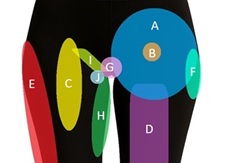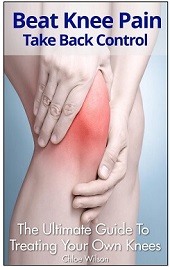- Home
- Hip Pain Diagnosis
- Upper Thigh Pain
Pain In Top Of Thigh
Written By: Chloe Wilson, BSc(Hons) Physiotherapy
Reviewed by: KPE Medical Review Board
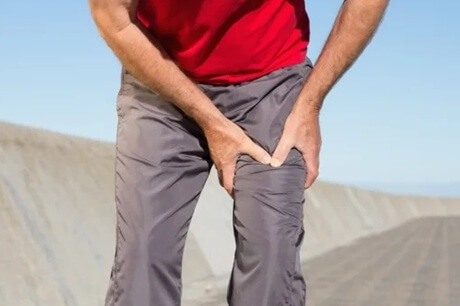
Pain in the top of the thigh can be a frustrating issue, affecting mobility and overall quality of life.
Upper thigh pain can present as a dull ache, sharp pain, burning sensation, or even tingling and numbness.
There are many potential causes of upper thigh pain, ranging from minor muscle strains and overuse injuries to more serious conditions such as nerve compression, circulatory issues, or joint disorders.
Here we look at the common causes of top of thigh pain, how they are diagnosed, when to see a doctor, and the best treatment approaches to relieve discomfort and restore function.
What Causes Upper Thigh Pain?
There are a number of different causes of pain in the top of the thigh that we have grouped into five sections:
- Muscle Problems: muscle strains, tendonitis, ITBS and contusions
- Joint Problems: arthritis, bursitis, fractures and osteochondritis
- Spinal or Nerve Problems: from the lower back or peripheral nerves
- Circulatory Problems: blood clots and vascular problems
- Other: rare causes of pain in top of thigh e.g. hernia, kidney stones and cancer
If you pain is higher up, check out the front hip pain article.
Muscle Problems
One of the most common causes of upper thigh pain is a problem in one of more of the muscles:
1. Muscle Strain
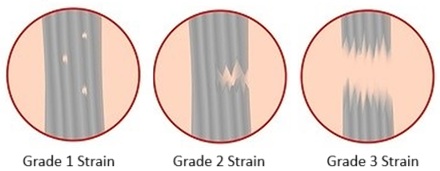
A common cause of upper thigh muscle pain is a strain.
A muscle strain occurs when muscle fibers are overstretched or torn, usually due to sudden movements, overuse, or lack of proper warm-up before physical activity.
Hamstring strains cause dull pain in the back of the thigh, while quadriceps strains affect the front. Hip flexor strains or groin strains, common in athletes, cause an aching pain in the front of the hip and groin and can make lifting the leg difficult due to pain and weakness.
2. Tendonitis
Another common cause of pain in the top of the thigh is tendonitis. This occurs when the tendons that connect muscles to bones become inflamed and damaged due to overuse or repetitive strain.
Hamstring tendonitis typically causes pain in the back of the thigh, while quadriceps tendonitis leads to pain in the front of the thigh. Symptoms include stiffness, weakness and discomfort that worsens with activity.
3. Iliotibial Band Syndrome (ITBS)
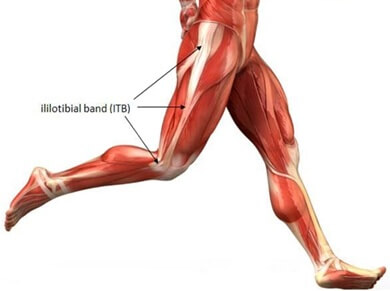
The iliotibial band (IT band) is a thick band of connective tissue running down the outer thigh from the hip to the knee.
Iliotibial band syndrome occurs when this band becomes tight, irritated and inflamed due to repetitive friction, often from running or cycling.
It leads to pain along the outer thigh, which typically worsens with activity and may extend to the outer knee. Find Out More >
4. Contusion
A contusion, or muscle bruise, occurs due to direct trauma, such as a fall or blow to the thigh. It causes localised upper thigh pain, swelling, and discoloration due to bleeding under the skin. Severe contusions can lead to deep muscle damage and restricted movement
Hip Joint Problems
Another common cause of pain in the top of the thigh is a problem in the hip joint which refers pain into the upper thigh:
1. Hip Impingement
A common cause of pain in the top of thigh is femoracetabular impingement, aka hip impingement syndrome.
With hip impingement, there is excess bone on one or both of the hip joint bones (femoral head and acetabulum) which causes friction and damage in the joint.
Hip impingement syndrome often affects athletes and active individuals. Common symptoms include deep, aching pain in the hip which may refer down the upper thigh, stiffness and clicking sensations.
2. Hip Arthritis
Osteoarthritis is a degenerative condition where the cartilage in the hip joint wears down over time, leading to pain that can radiate to the thigh.
Rheumatoid arthritis, an autoimmune disorder, also causes inflammation and joint pain, affecting mobility. Symptoms of hip arthritis include stiffness (particularly in the morning), restricted motion, inflammation, and worsening top of thigh pain with movement
3. Hip Bursitis
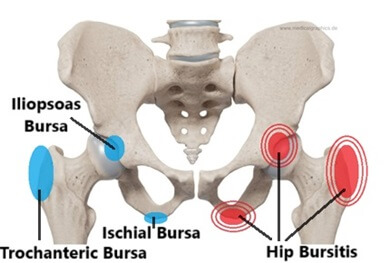
The hip joint contains a number of fluid-filled sacs called bursae that help reduce friction between tissues.
When these sacs become inflamed due to repetitive motion or trauma, it leads to hip bursitis, which causes sharp pain in the hip that can spread to the thigh. Hip bursitis symptoms worsen with prolonged standing, sitting or walking.
Trochanteric bursitis causes outer thigh pain, iliopsoas bursitis causes pain at the front of the upper thigh, and ischial bursitis causes pain in the top of the thigh under the sitting bones
4. Hip Labral Tear
Another common cause of pain in the top of the thigh is a hip labral tear. The hip labrum is a ring of cartilage that lines the hip socket, improving joint mobility and stability.
Hip labrum tears may be caused by an acute injury or degenerative wear and tear, and typically affect active people. The classic symptoms of hip labrum tears are a deep aching pain in the hip with clicking sensations and sharp hip pain with movement.
5. Injury
Direct trauma, such as falls, car accidents, or sports injuries, can lead to fractures or dislocations of the hip. A hip fracture is particularly common in older adults with osteoporosis and can cause severe pain in the upper thigh and groin.
Dislocations, where the ball of the hip joint comes out of place, can also result in extreme pain and immobility, but are rare. Stress fractures or traumatic fractures of the femur can cause significant top of thigh pain, swelling, and difficulty bearing weight on the affected leg.
6. Osteochondritis Dissecans
This condition occurs when a small section of bone and cartilage in the joint loses blood supply and dies, leading to pain, stiffness, and joint dysfunction. Osteochondritis is more common in children and young adults and can cause deep aching pain in the hip and thigh region as well as the knee.
Back/Nerve Problems
Pain in the top of the thigh may be due to a problem in one of the nerves from your lower spine or may actually be referred pain from your lower back, even if you don’t have any symptoms in the back itself:
1. Peripheral Neuropathy
Peripheral neuropathy occurs when the peripheral nerves, which carry signals between the spinal cord and the limbs, become damaged. Causes include structural changes in the spine, diabetes, infections, vitamin deficiencies, and certain medications.
Symptoms of peripheral neuropathy include tingling, burning pain in top of thigh, numbness, and muscle weakness. Symptoms typically affect one leg and may radiate down to the feet.
2. Spinal Stenosis
Spinal stenosis occurs when the spinal canal narrows, putting pressure on the nerves in the lower back. Stenosis commonly affects older adults and can cause pain that radiates from the lower back into the upper thigh, along with numbness, weakness, and difficulty walking, particularly downhill. It may affect one or both legs.
3. Meralgia Paresthetica
Meralgia paresthetica occurs when the lateral femoral cutaneous nerve, which supplies sensation to the outer thigh, becomes compressed. Causes include obesity, tight clothing, pregnancy, or prolonged standing.
Symptoms of meralgia paresthetica include shooting or burning upper thigh pain, tingling, and numbness in the outer thigh without muscle weakness. It usually only affects one leg.
Circulatory Problems
Problems in the blood vessels are a potentially serious cause of pain in the top of the thigh:
1. Deep Vein Thrombosis (DVT)
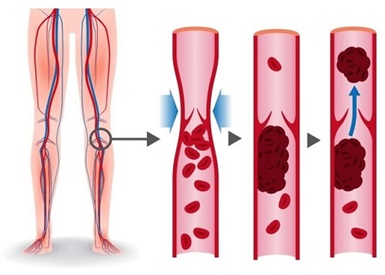
A DVT is a blood clot that forms in the deep veins of the leg, usually due to prolonged inactivity, recent surgery, or underlying clotting disorders.
Symptoms include swelling, warmth, redness, and pain typically in the thigh or calf.
A DVT can be life-threatening if the clot dislodges and travels to the lungs (pulmonary embolism), heart (heart attack) or brain (stroke), making it a medical emergency.
2. Peripheral Artery Disease
Peripheral artery disease (PAD) occurs when plaque builds up in the arteries, restricting blood flow to the legs. It often causes cramping and pain in the top of the thigh, especially during walking or exercise (claudication). In severe cases, reduced blood flow can lead to tissue damage and ulcers
Other Causes of Upper Thigh Pain
There are some other more unusual causes of pain in the upper thigh including:
- Hernia: A femoral or inguinal hernia occurs when abdominal tissue pushes through a weak spot in the muscle, causing pain and discomfort in the upper thigh and groin. You can often feel a bulge or lump in the groin (inguinal hernia) or upper thigh (femoral hernia) region
- Kidney Stones: Large kidney stones can cause referred pain in the upper thigh, along with severe back pain, nausea, and difficulty urinating
- Cancer: Bone or soft tissue tumors in the thigh or pelvis are rare but can lead to persistent upper thigh pain, swelling, and, in some cases, unexplained weight loss
- Diabetes: Poorly controlled diabetes can lead to diabetic neuropathy, causing burning pain, numbness, and tingling in the upper thigh, and often affects sensation in the feet
Symptoms Of Upper Thigh Pain
Symptoms associated with pain in the top of the thigh will vary depending on the underlying cause but typically include:
- Pain & Tenderness: Dull, aching, sharp, or burning pain in top of thigh. The pain often worsens with movement or after prolonged inactivity
- Stiffness: and reduced range of motion in the hip and/or knee
- Swelling: or redness, if inflammation or blood clot is present
- Numbness: or tingling with nerve-related conditions in the upper thigh that may radiate down the leg
- Muscle Weakness: or cramping with upper thigh muscle pain
- Difficulty Walking: or going up and down stairs
Diagnosis
To determine the cause of upper thigh pain, doctors may perform a combination of:
- Physical Examination: Assessing mobility, tenderness, and strength in the hip, thigh and knee region
- Imaging Studies: X-rays are used to assess for bone damage e.g. arthritis or fractures. MRI scans are used to identify soft tissue e.g. muscles, tendons or spinal issues. CT scans may be used for joint and muscle issues.
- Ultrasound/Doppler Test: To check for DVT or circulatory issues
- Nerve Conduction Studies: To diagnose neuropathy or nerve compression e.g. EMG studies
- Blood Tests: To rule out inflammatory or clotting disorders
When To See A Doctor
If you have pain in the top of the thigh associated with any of the following symptoms, seek medical attention:
- Severe or persistent pain in top of thigh
- Following significant trauma, especially if there is an obvious deformity
- Swelling, redness, or warmth in the thigh - possible DVT
- Numbness, tingling, or muscle weakness
- Upper thigh pain worsens with activity and does not improve with rest
- Signs of infection, such as fever or skin changes
- Sudden, severe chest pain which may extend to shoulder, arm, face or neck
- Rapid or irregular heart rate
- Sudden shortness of breath or rapid breathing
- Clammy or blueish skin or lips
- Fainting or light headedness
- Unable to walk, do stairs or limits normal daily function
Treatment For Upper Thigh Pain
Treatment for pain in the top of the thigh will depend on the underlying cause and may include:
- Rest and Activity Modification: Avoiding activities that aggravate your pain in top of thigh
- Strengthening Exercises: to improve the strength and control in the thigh - Quads strengthening (front of thigh), hamstring strengthening (back of thigh), and glute strengthening (buttock muscles)
- Stretching Exercises: to improve flexibility and mobility – Quads stretches (front thigh), hamstring stretches (back thigh), ITB stretches (outer thigh) and piriformis stretches (buttocks)
- Physical Therapy: A PT will be able to give you a personalised rehab program and may use electrotherapy e.g. ultrasound treatment for muscle strains, or taping for strain or tendonitis
- Massage Therapy: Helps relax muscles, reduce stiffness, and improve circulation, especially for upper thigh muscle pain
- Medications: You may be given NSAIDs for pain and inflammation; muscle relaxants for muscle-related pain; blood thinners for DVT
- Injections: Corticosteroid injection can help reduce inflammation, or nerve blocks can help with chronic pain conditions
- Surgery: may be required for severe cases like hip fractures, nerve decompression, or vascular issues
Pain In Top Of Thigh Summary
Pain in the top of the thigh can stem from muscle injuries, joint issues, nerve compression, or circulation problems. Identifying the cause of upper thigh pain through proper diagnosis is key to effective treatment.
Mild cases can improve with rest and physical therapy, while serious conditions like DVT require urgent medical attention. If symptoms persist or worsen, consult a healthcare professional for evaluation and management.
You may also be interested in the following articles:
- Front Hip Pain
- Outer Hip Pain
- Pain Above The Knee
- Front Knee Pain
- Swelling Behind The Knee
- Leg Strengthening Exercises
- Knee Pain Diagnosis Charts
Related Articles
Page Last Updated: June 20th, 2025
Next Review Due: June 20th, 2027

